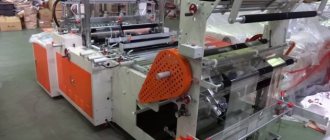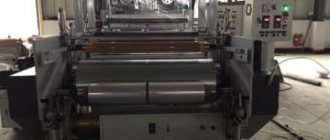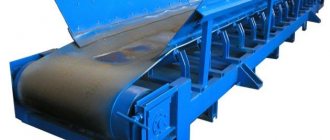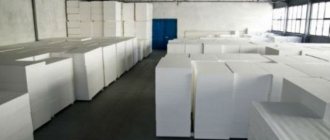* The calculations use average data for Russia
1,000,000 - 7,000,000 ₽ Starting investment
480,000 - 2,400,000 ₽ Revenue
280,000 - 1,400,000 ₽ Net profit
18 months Payback period
The production of paper packaging is a promising business that can pay for itself in 1.5 years and provide a profitability of 25%. Affordable equipment for the production of paper bags, a simple technological process that even a novice entrepreneur can master
Overview of the market for the production of paper bags and bags
Every year, humanity pays more and more attention to protecting the environment. The popularity of environmentally friendly, environmentally friendly products made from (or with) renewable resources is growing: hybrid cars and electric vehicles, healthy food without the use of genetically modified organisms, and much more. This also affected packaging materials. In many countries, supermarkets offer a choice of a free bag made of paper and other environmentally friendly materials or a paid plastic (polyethylene) bag. Some countries are completely abandoning plastic packaging, using paper and textiles instead. Existing production facilities are being repurposed in accordance with new market demands. Today, one of the promising business areas is the production of paper bags, which remains the most environmentally friendly and affordable alternative to plastic packaging.
In Russia, paper packaging is not as popular and widespread as in Europe. However, various studies and surveys of entrepreneurs involved in the production of paper packaging indicate positive market dynamics. The market capacity of paper bags and sacks, according to various estimates, is in the range of 700 million - 1.5 billion rubles. Consequently, this business segment is quite promising, especially against the backdrop of the popularization of environmental problems. The demand for paper packaging is growing. Particularly because there is a huge amount of materials that are prohibited from being packed in plastic bags. For example, a number of food products (flour and sugar), coal for barbecues (here the paper bag carries a double load: it is also used for ignition), some building materials (gypsum, alabaster, cement, etc.) and much more.
Therefore, the market for paper bags is practically unlimited, and an enterprise for their production is one of the win-win options for your own business. It is not tied to raw materials or location. The raw material is thick paper, often made from recycled materials, which is produced in abundance in Russia. Paper bags are in demand in a wide range of industries, equally in large and small cities, towns and other settlements. The dimensions of the equipment used in production are quite compact, which will save on space rental. Moreover, even a person without experience can work on such equipment.
A manufacturer of paper bags and sacks has a virtually unlimited advertising resource, which can be either sold (that is, put third-party advertising materials on your products) or used for your own marketing purposes (print your own advertising). In the first case, this provides considerable additional income, quite comparable with income from the main activity. In the second, it allows you to do without the costs of promoting your products.
Advantages and disadvantages of paper packaging production
| ADVANTAGES | FLAWS |
|
|
Thus, the production of paper packaging is a relevant area for business, since the demand for this type of packaging will grow every year. This will ensure stable profits and business development.
Technology for making paper bags
Five main stages:
- Blanks. At this stage, a tube of paper is created, which will pass through the conveyor and be cut into individual bags. This stage includes applying logos and branding to the workpiece.
- Gluing and forming the bottom.
- Valve blanks that can be closed or sealed.
- Final gluing and pressing for ease of transportation.
- Formation of ready-made packages with a certain number of bags.
Let's look at the types of printing for different industries. The most popular is offset on a scan. Flexography can be used, however, this technology is complex and is used for more prestigious products. Silk-screen printing is needed for applying single- or multi-color simple images, and it can be used even with small batches of goods. Embossing is the least popular method, requiring high costs, manual labor or special expensive equipment, so it is used only for creating high-quality paper gift bags.
Don't forget about handles, which can complicate the process and require additional investment to purchase equipment.
Sales organization, target audience identification
Before you start directly implementing a business idea for the production of paper bags and packages, you should determine the need for these products in the local region and study the target audience. To do this, you need to understand what paper packaging is used for and where it is used. This:
- food storage;
- food packaging (fast food, fast food outlets);
- packaging and transportation of dry construction mixtures or charcoal;
- design and decor of flower arrangements;
- packaging of gifts and souvenirs;
- safety of production parts;
- packaging of compost and household products;
- promotional material.
Based on the use of paper packaging, it is possible to determine who will be the main consumer of the product. Experts identify the following areas of consumption where paper packaging may be in demand.
Main consumers of paper packaging
| Consumers | Purpose | Demand level |
| Supermarkets | As a replacement for plastic shopping bags or disposable food containers in stores that adhere to so-called "green standards". | Demand is low, free disposable plastic bags are still in demand |
| Bakeries | For packaging baked goods | Demand is slightly below average, but the dynamics are positive |
| Restaurants and fast food establishments | For packaging takeaway products | Demand is low but stable |
| Gift and clothing stores | In the form of gift packaging | Demand is high, especially during holidays |
| Stores and factories for the production of bulk products | As a container for bulk products that are susceptible to condensation, including building mixtures. | Demand is high, but competition is high |
| Advertising companies | With a logo applied when conducting marketing or advertising campaigns | Demand is slightly above average, the dynamics are positive |
In addition to the above sales areas, there are many more industries and enterprises that use paper types of containers. Therefore, it will not be difficult for the manufacturer to find potential customers to sell their products.
To open a mini-production of paper packaging, you should focus on the mass consumer. By signing an agreement for the supply of your products with a supermarket, bakery or other large enterprise that uses paper packaging, you can ensure production of a certain number of orders and establish stable sales. This will be the first step towards organizing a highly profitable and promising business.
Advantages of paper bag production
Paper bags compare favorably with plastic bags. The latter are not designed for storing certain goods, for example, charcoal, food products that lose their original qualities - flour, coffee, spices. Applicable to fast food cafes, small fast food kiosks for takeaway packaging.
The packages are needed to promote the company’s image advertising; promotional items with the organization’s logo are given in them and used at presentations and exhibitions. Their production is the most promising and stable type of small business.
Technology for the production of paper bags and packages
An aspiring entrepreneur is obliged to study the production technology of his future products. Select high-quality equipment for the production of paper bags. Understanding the intricacies of making paper packaging is not difficult. This is a simple and quick process that does not require significant time and money investments.
The paper bag production process consists of 5 technological stages:
- Production of blanks according to a pre-developed project.
The bag blank is a multilayer glued paper tube. Using a special installation for mixing soluble glue, the workpiece is glued. Some types of paper packaging require perforation. This process is carried out automatically or semi-automatically using a hammer drill.
- Applying a logo or design.
For these purposes, various modern application methods are used - offset printing, flexography. You can choose the most optimal option for your production by contacting the printing house with which you plan to cooperate.
- Preparation of valves.
This step is assumed if closed bags with a valve are produced. Valve blanks are made on a semi-automatic paper tape cutting machine. The valve itself is manufactured on a valve machine.
- Firmware or gluing the bottom of the package.
Paper bags are divided into two types: stitched and glued. They are distinguished by their strength (the stitched ones are somewhat stronger than the glued ones), as well as their production time and cost - the former are more expensive, since their production requires a nylon thread. It is recommended to choose one of the types of paper bags for production, since different fastening methods require different equipment. For glued bags, final gluing is used using a press, and for stitching, a device is required that performs multi-layer stitching on the bottom of the paper product.
- Pressing and baling in a packaging plant.
The bales are then labeled and stored, or transported directly to the buyer.
Making paper bags is a business idea that won't fail
Paper is an economical, practical and environmentally friendly type of packaging material, unlike plastic, which harms the Earth's ecosystem. Many European countries have already completely abandoned plastic bags. In Russia, thousands of people supported the “Break with the package” and “Package? - Thanks, no".
The entire civilized world is returning to paper packaging. The number of plastic bags is gradually being reduced, and an additional tax is planned to be introduced for Russian manufacturers of such products from 2020.
The government is developing measures at the legislative level that will make the use of paper containers more efficient and widespread in the coming years. Therefore, producing paper bags will only become more profitable.
What other reasons make this type of production a winning option for starting your own business?
Let's name 5 main ones:
- Paper bags are in demand in various industries: from restaurants to construction companies. Structural changes made it possible to significantly increase their “carrying capacity”. In addition, some products and materials can only be stored in paper (flour, sugar, building mixtures).
- Demand for products does not depend on the size of the locality. Packages are equally in demand in large cities and small towns.
- Clear production technology. It can be simplified to the following scheme: making a paper tube blank - applying an image (optional) - fixing and securing the bottom (gluing or stitching) - inserting a valve (optional) - packing into bales (pressing).
- A large number of raw material suppliers.
- High profitability (30-40%) and quick payback (12-13 months).
Equipment for the production of paper bags and bags
Today there are many proposals regarding the acquisition
equipment for the production of paper bags
for the production of paper bags and packages, but the fundamental difference lies in the power of the equipment.
The latter, as a rule, determines the type of equipment: low-power lines are semi-automatic mini-factories, and high-capacity lines are automated in most cases. Of course, the price depends on the type of line. Depending on your starting capital, you can purchase production lines that are completely different in price and characteristics. The basic minimum consists of: a machine for multi-layer gluing of workpieces, equipment for forming and gluing bags, stitching machines. As the business develops, production can be gradually expanded by purchasing additional equipment. For the initial stage, you can organize a small workshop with a production volume of no more than 250 bags per hour.
You can purchase new or used equipment. For example, a used UBT-200M (semi-automatic) machine can be purchased for 300-400 thousand rubles and equipped with additional equipment. Then the minimum production line will cost approximately 700-900 thousand rubles.
Let's take a closer look at the cost and equipment of the new automated line.
Equipment for the production of paper packaging
| Device | Power | Application | Cost, thousand rubles. |
| UBT-3000 | up to 120 workpieces per minute, Number of workpiece layers: 1-5. | The line automatically produces blanks of 1-5 layers with longitudinal and transverse gluing, with the application of sector perforations and longitudinal cuts | 3195 |
| UBK-2 | Capacity: up to 80 valves per minute | Produces single paper valves of various sizes for gluing into closed type bags (valve bags) | 298 |
| PPM-ZE | (included in the price of UBT-3000) | Lifting and moving mechanism | 240 |
| USD-6M | open bags - up to 550 pcs. at one o'clock; closed bags - up to 250 pcs. at one o'clock. | Machine for forming and gluing the bottom of open and closed paper bag | 369 |
| RK-100 | — | Installation for mixing cold-soluble glue | 196 |
| MKL-19R(A) | up to 5000 meters of single belt per hour, which generally corresponds to the productivity of the line as a whole | Semi-automatic machine for cutting fastening, interlining and covering tape (sheets) | 198 |
| PFM | PFM-2 (two-color printing) | Devices for printing flexographic PFM, which can be equipped with a UBT-200M machine | 1496 |
| PFM-3 (three-color printing) | 1783 | ||
| PFM-4 (four-color printing) working speed – 95 m/min | 1987 | ||
| PKM-10 | — | Hydraulic bag bale press | 691 |
| Prices for equipment are presented on the website www.meshkodel.ru | |||
This table will allow you to calculate the cost of equipment and plan production. For example, equipping a line that produces up to 800 thousand open or 360 thousand closed bags per month, with printing up to 2 colors, will cost 6.5 million rubles.
Such a large difference in prices is easily explained by productivity, which is up to 120 blanks per minute, regardless of the number of paper layers in the bags produced (from 1 to 5). Please note that it is advisable to purchase a hydraulic bale press and an installation for mixing glue only for large-scale production. If you plan to organize a small workshop, then you can do without this equipment. Another important point: only low-power lines can be equipped with additional equipment; and high-capacity lines are usually sold complete, configured and adjusted to certain production parameters.
Technically, the line for the production of paper bags and packages consists of the following units and blocks: an unwinding unit, a unit for interlayer transverse sizing of paper layers, a unit for longitudinal sizing of paper layers, a device for forming a paper sleeve with one side fold (rebate) and three side folds (rebates) according to GOST R53361-2009, a perforation unit (up to 144 holes with a diameter of up to 3 mm) with a longitudinal cutting device for making a glued bottom of a bag, a device for drawing and cutting a sleeve with a counter of finished paper tubes, a conveyor and a receiver of finished products. Production is fully automated and controlled from the control panel.
Separately, it should be noted that the line for the production of paper bags and packages also has the useful property of being reconfigurable to the desired format of the products (length - from 30 to 120 cm; width - from 20 to 61 cm for the described line), unlike mini-factories, producing packages or sacks only in a predetermined and set format and requiring constructive additions to change it.
The line is usually equipped with additional flexographic printing units, as well as a lifting and moving mechanism for installing paper rolls weighing up to 1 ton, which automates the feeding of paper rolls. There are any types of paper bags produced.
Assembly-gluing
Assembly is carried out by hand by skilled, experienced assemblers. As the practice of Russian and Western manufacturers has shown, assembly on automatic lines does not withstand any competition for medium runs in terms of price and speed, and the quality is much inferior to manual assembly. Many including in Russia they bought such lines in China and now they don’t know how to get rid of them. In addition, the machines have a very small range of sizes, while manually you can assemble from the tiniest jewelry bag to huge bags of 2 A1 sheets. The bags are assembled 90% using acrylic glue from Henkel and hot melt adhesive. Double-sided tape is used less frequently for two reasons: firstly, good quality tape is quite expensive and can reach 5-6 rubles/pack, and secondly, almost any tape can lose its adhesive properties over time, especially in winter and during storage in a cold warehouse. All bags are necessarily reinforced with a bottom and a support made of 300 g thick cardboard.
Raw materials and consumables
One of the advantages of paper packaging production is the availability of raw materials. Here you can use paper of any type, structure and density. The most commonly used materials are cardboard, craft, coated paper, efaline, luxury pack, and art libris. In the production of paper bags, thick paper is used from recycled materials, for example, from recycled waste paper. To make paper bags with handles, cardboard or any other thick type of paper is used.
The cost of regular sack paper is 65 rubles. per kg, and kraft paper sacks and laminate - 50 and 130 rubles. per kg respectively. High transport costs make it unprofitable to purchase one roll; in addition, the cost of kg of paper in large rolls is lower, so bulk purchasing is recommended. The minimum working capital for semi-automatic production is estimated at 200-300 thousand rubles.
Production of craft bags
Kraft bags are products made from Kraft paper, which is produced using a special technology using kraft cooking of coniferous wood. Has increased strength indicators. In addition, kraft paper is a breathable material, which allows products stored in such packaging to exchange air with the environment when temperature and humidity changes. Such bags are often used for bulk food products (flour, sugar, salt). The image on craft bags is usually applied using flexographic printing, and sometimes offset printing.
Personnel and premises for the production of paper bags and sacks
The choice of premises when organizing the production of paper containers has fairly flexible criteria. Therefore, there should not be any difficulties in this process. The main factors that you should pay attention to: the room must be equipped with water supply, sewerage and electricity with a voltage of 380 V. Increased attention to fire safety is also required, because The main raw materials are flammable materials. Smoking and the use of heating devices (except for steam and oil radiators) in the workshop is prohibited.
Required production area – 100 sq. m. This will be enough to accommodate a workshop with equipment, a warehouse for raw materials, a rest room for workers and a director’s office. The cost of renting such an area may vary depending on the location and region. For this business, the location of production is not so important, so you can choose a more budget-friendly option on the outskirts of the city or in an industrial zone. The average rental cost is 100-150 sq.m. for Moscow and St. Petersburg will be approximately 60 thousand rubles, for Russia - 34 thousand rubles.
The average rent for industrial premises is 100-200 sq. m. meters*
| REGION/SQUARE | 100-150 kV. METERS | 150-200 kV. METERS |
| Moscow and St. Petersburg | 59 651 | 91 438 |
| Average for Russia | 34 042 | 44 996 |
* according to the Avito website as of 04/02/2018
Regarding the personnel, it should be said that the majority of workers belong to the category of unskilled workers under the leadership of a foreman, who is also a technologist, and their number directly depends on the type of line and installed equipment. For example, UBT-3000 is operated by 2 people, a printing device of any type is operated by 1 person, a technologist (foreman) sits at the control panel, etc.
In general, any unit requires one operator, except for the aforementioned UBT-3000 and USD-6M, which must be serviced by two. On average, 4-5 people are required to operate one mini-line, while a “large” line requires 8-10. This example assumes a staff of 4 employees who will work in shifts. This will improve the efficiency of workers and eliminate machine downtime.
Necessary technical equipment
The bags are stitched and glued. Various types of machines are required.
Equipment costs depend on their productivity, cost of installation and line type. The most ordinary machine will cost about 190 thousand rubles, one that can make multilayer paper - 430 thousand rubles, a mixed type - approximately 880 thousand rubles. If possible, choose a mixed type machine. It will quickly pay for itself - in an hour of work it is possible to produce 210 blanks in two layers at once. A fully automated installation is best.
Please note: You can contact our partners with a quality guarantee.
Start-up and monthly expenses of the enterprise
Depending on the planned scale of the project, the initial investment in the paper bag production business can range from 1 to 7 million rubles. As an example, calculations are carried out for a price equipped with an automated production line UBT-3000. More accurate cost calculations and income forecasts can be obtained by developing a business plan that will take into account all the nuances of a particular project. The main costs for starting a business from scratch in this case consist of the following expense items:
- rental of production space – 120 thousand rubles;
- purchase of equipment – 6.5 million rubles.
You should also consider the costs of setting up a business. Since the production of paper packaging is aimed at corporate clients, it is recommended to register an LLC. The main type of activity, according to the OKVED-2 classification, should be indicated: 17.21 Production of corrugated paper and cardboard, paper and cardboard containers.
Activities for the production of paper packaging are not licensed. You only need to obtain permission to open from the Fire Service and the SES. Thus, the cost of solving bureaucratic procedures will be about 20 thousand rubles. In addition to the initial investment, there are monthly expenses, which include employee salaries, utility bills, rent and taxes.
Startup and monthly costs
| № | EXPENDITURES | AMOUNT, RUB. |
| Initial Investment | ||
| 1 | Rent of workshop 200 sq.m. m. | 120 000 |
| 2 | Enterprise registration | 20 000 |
| 3 | Production equipment | 6 500 000 |
| 4 | Furniture, office equipment | 70 000 |
| 5 | Purchase of raw materials | 100 000 |
| 6 | other expenses | 20 000 |
| Total: | 6 830 000 | |
| Monthly expenses | ||
| 1 | Rent of workshop 200 sq.m. m. | 120 000 |
| 2 | Purchase of raw materials | 180 000 |
| 3 | Communal payments | 20 000 |
| 4 | Salary for 4 employees | 100 000 |
| 5 | Taxes | 280 000 |
| 6 | Depreciation | 55 000 |
| Total: | 755 000 | |
How much money is needed to start a project (financial plan)
The main cost item at the start is the purchase of equipment. Your choice significantly influences the amount of starting capital. The cost of the automatic line, which we have already mentioned, ranges from 2.5 to 5 million rubles.
If you purchase semi-automatic equipment, separate for each operation, then the cost of the equipment, depending on the manufacturer and options, will range from 800 thousand to 1 million rubles. For basic calculations, we will focus on this option.
Then we include in the main expenses:
- Business registration – 15 thousand rubles.
- Rent of premises (without renovation) – 50 thousand rubles.
- Equipment – 900 thousand rubles.
- Office equipment, furniture – 110 thousand rubles.
- Raw materials - 90 thousand rubles.
- Transport – 300 thousand rubles.
- Additional expenses – 40 thousand rubles.
Total: RUB 1,415,000*
*If the workshop cannot be used without preliminary repairs, then costs increase by 100-110 thousand rubles.
Monthly expenses are added to the starting costs:
- Rent – 50 thousand rubles.
- Raw materials – from 300 thousand rubles.
- Utility bills (water, electricity) – 50 thousand. rub.
- Staff salary – 200 thousand rubles.
- Taxes – 65 thousand rubles.
- Fuel – 30 thousand rubles.
Total : RUB 695,000*
*Calculation does not include advertising and promotion costs.
Profitability of production, income
With proper business organization, the production of paper packaging can bring high income to its owner. The monthly revenue of a small enterprise can reach 1 million rubles. But automated production can bring many times more. To calculate profit, it is necessary to determine what the cost of manufactured products will be. How to calculate the cost? Using the following indicators:
- The average cost of raw materials is 50 rubles. per kg;
- consumption for 1 package measuring 120x150x50 mm is 0.09 kg of raw materials.
- other expenses (employee salaries, energy costs, depreciation, etc.) for 1 package – 0.5 rubles.
Based on these data, the cost of 1 package will be 5 rubles. With a retail price of about 12 rubles, the profit from the sale of 1 package will be 7 rubles. Now you can calculate the profit received from production on a semi-automatic machine (250 bags per hour). In a month, the number of working hours will be about 160 hours, during which 40,000 packages can be produced. Revenue from the sale of this volume of products will be 480 thousand rubles
The automatic line can produce from 200 thousand pieces. per month. In this case, the revenue will be 2,400 thousand rubles.
If we subtract the cost, we get a profit before tax equal to 280 and 1,400 thousand rubles, respectively. After paying taxes, net profit will be about 240 thousand rubles. for semi-automatic production and 1,120 thousand rubles for an automated line. At this level of profit, the initial investment can pay off within 1.5 years. And the profitability of the business will be 25-30%.
Profitability of starting a paper bag business
Almost any business requires strength, knowledge, skills, patience and money. Let's calculate an approximate business plan for the production of paper bags. Let's use the data above as an example. An example of opening the production of both types of bags on new equipment.
Purchase of equipment. The cost of equipment with installation is 5,703,500 rubles. The calculation was made above. We are buying new equipment.
Costs for opening a company (5000 rubles). You can open an individual entrepreneur or LLC. We are opening an IP. Payment of state duty is 4,000 rubles (data for 2016). Making a seal costs 1,000 rubles (required only for LLCs). The cost of registration costs will be 5,000 rubles.
Rental of premises and expenses were discussed above. We need a room so that we can place equipment, warehouse, store finished products, and a rest room for workers. The production premises must be equipped with cold water, electricity 380 kV, toilet, shower.
We will calculate our production based on the production of four-layer open paper bags, with printing, dimensions 65*49.5*13, selling price 17 rubles per piece.
Cost of paper for the production of bags. For the production of paper bags, sack paper GOST 2228-81 is used, the average market price is 55,000 rubles per ton. To produce one of our four-layer bags you will need 216 grams. paper. Density for calculation is taken as 78 g/m2.
Glue and flexo paint for production. Generally, adhesives based on modified potato starch are used for multi-layer paper bags. The average cost of glue consumption per bag is 0.34 rubles. The cost of flexo paint will be 0.5 rubles per bag, depending on the color and degree of filling of the canvas.
Staff. Two employees are enough to operate our equipment; the project initiator himself will be responsible for monitoring production and its sales. Accounting – outsourcing, cost 10,000 rubles per month.
Next, we will summarize the initial data in tables and calculate the profit and payback of our business.
Table 1. Initial costs
| Total | |
| year | |
| Purchase of equipment | 5703500 |
| Working capital | 3080658 |
| Organizational expenses | 5000 |
| Total expenses | 8789158 |
Table 2. Staff
| Job title | Qty | Salary | Total |
| Human | rub/month | Payroll | |
| Worker | 2 | 25000 | 50000 |
| TOTAL | 2 | 25000 | 50000 |
Table 3. Payroll taxes
| Total | Total | |
| 1 year | 2 year | |
| Worker | 550000 | 600000 |
| TOTAL PAYROLL | 550000 | 600000 |
| TOTAL TAXES | 165000 | 180000 |
Table 4. Revenue calculation
| Total | Total | |
| 1 year | 2 year | |
| Revenue from the sale of bags | 51000000 | 61200000 |
| Total revenue | 51000000 | 61200000 |
Table 5. Fixed and variable costs
| Total | Total | |
| 1 year | 2 year | |
| Fixed expenses | ||
| Wage | 550000 | 600000 |
| Payroll taxes | 165000 | 180000 |
| Rent | 660000 | 720000 |
| Depreciation | 5703500 | 0 |
| Accountant services | 100000 | 120000 |
| Variable expenses | ||
| Paper | 39204000 | 42768000 |
| Glue | 1122000 | 1224000 |
| Dye | 1650000 | 1800000 |
| Communal expenses | 165000 | 180000 |
| Electricity | 116160 | 126720 |
| Transport | 220000 | 240000 |
| 165000 | 180000 | |
| Insurance individual entrepreneurs | 530153 | 632153 |
| Other variable expenses | 350000 | 420000 |
| Total costs | 50700813 | 49190873 |
Table 6. Business income and expenses
| Total | Total | |
| 1 year | 2 year | |
| Enterprise revenue | 51000000 | 61200000 |
| Production cost | 50700813 | 49190873 |
| Gross profit | 299187 | 12009127 |
| Loan interest | 0 | 0 |
| Profit before tax | 299187 | 12009127 |
| Taxes | 510000 | 840639 |
| Net profit | -210813 | 11168488 |
| Net profit with cumulative total | -210813 | 10957674 |
Tab. 7. Final calculation
| Planning horizon | 2 years | |
| Enterprise revenue, rub. | 112200000 | |
| Enterprise profit, rub. | 10957674,47 | |
| Investments in the project, rub. | 8789158 | |
| Payback period, months | 13 | |
| Profitability,% | 9,8 | |
Possible risks of paper bag production
Before deciding to open a paper packaging business, you should assess the possible risks of the project. The main problem affecting the profitability of production is the search for cheap raw materials. Therefore, it is recommended to use recycled materials and purchase consumables in bulk.
Another important problem is finding buyers. Agreements regarding future packaging supplies should be made before production begins. Grocery and retail stores, bakeries, fast food establishments, printing houses, agricultural and industrial enterprises producing mineral fertilizers and building materials may be interested in your products. To work with potential clients, it is recommended to develop a commercial proposal and presentation of your products. Work on finding clients must be carried out constantly so as not to lose the pace of sales and profits. It is recommended to start looking for customers and potential clients long before equipping your line with all the necessary production equipment and before producing the first batch of goods.
Due to the fact that specialized equipment is involved in production, technological risk should be taken into account. Breakdown of machines can lead to a complete stop in production and lead to loss of profits. To minimize this risk, equipment and its suppliers should be selected carefully. It is advisable to purchase new machines without trying to save on used ones. Now some suppliers of specialized equipment also offer maintenance and repair services. This is very convenient, as it simplifies the process of managing technology risks.
Various ways to print on paper packaging
Different printing techniques are used depending on the types of production. The most popular at the moment is offset printing. It is used for mass circulation.
Flexography is also a common method. But it is worth understanding that this option is used mainly by organizations that have already found their feet and want to further raise their prestige, because flexographic printing is much more expensive than offset printing.
In addition to flexography, silk-screen printing is also used. It is used for applying both single-color and multi-color images. But unlike previous methods, they are also used in the production of small batches of goods.
Embossing is an expensive method, and therefore the least popular among manufacturers. By the way, in addition to financial costs, you will need to expend manual labor, as well as buy expensive equipment. These factors are the reason why embossing is used exclusively to create gift wrapping and high-quality paper bags. Accordingly, the price of the finished product is far from the market minimum.
Manufacturing and attaching handles to finished bags also leads to an increase in the price of the finished product, as it complicates the production process and requires additional costs for equipment.
Some tips for beginners
To consolidate the information, we repeat the main recommendations when starting a business for the production of paper packaging:
- To save on the purchase of consumables, purchase recyclable materials.
- High-tech equipment for the production of paper bags is more expensive, but very economical in energy consumption. Pay attention to the characteristics of the purchased devices.
- A client base can be created and expanded using Internet resources: create your own website, send a commercial offer by email to potential clients, add information about the company on various forums and social networks. networks, place advertising videos on popular portals.
- It is best to contact customers and regular clients before starting production or at the initial stage of work.
- For a more accurate study of the sales market, production planning and profit forecasting, develop a business plan. This will allow you to take into account all the nuances and competently plan all business processes.
Premises and staff
The premises that an entrepreneur rents for a production workshop must be equipped with water and electricity, and also comply with fire safety standards. Planning and renovation can be done at your own discretion. When installing equipment, you must follow the instructions included with the technical devices.
The production of paper bags for food and household needs can be controlled by 3-4 specialists working in shifts. You can hire people without special education, it is important that they have some skills in this field of activity.
How much money will you need to start a business?
To manually assemble paper bags, you will need approximately 50 thousand rubles for equipment, shelving for semi-finished / finished products and long tables. For the first batch of 3 thousand bags, up to 100 thousand rubles will be spent on materials - paper, glue, threads, ropes, tape. In this case, the business plan for producing packages is extremely simple:
- registration as an individual entrepreneur,
- purchasing blanks in an online store (search engine to help),
- assembling packages at home (YouTube helps),
- delivery for sale to stores.
“And then 100 thousand rubles will become working capital in this business,” explains Natasha Babkova. – You won’t have to count on more than 30 thousand rubles of income per month. However, even if you borrow money to develop a small business, the return on investment can be achieved in six months. In principle, you can start with a batch of 100-200 bags. How much money is needed to open will depend on the circulation chosen.”
For automatic production on an industrial scale, you will need an entire production workshop with an area of 100 or more square meters. m for installation of equipment for the production of paper bags, and high energy consumption is guaranteed. True, the absence of manual labor significantly increases the profitability of production even with a low price tag for finished products.
“Count on investments of eight million and above,” says Andrei Govorkin. – From my own experience, I know that in this business there is a large share of unforeseen expenses. In particular, it may be necessary to install a small gantry crane to move paper rolls. Don’t buy a forklift just to operate it 10 minutes a day.”
That is why, most often, the balanced costs of starting a business predetermine the bet on semi-automatic lines. The main stages are automated here: gluing (or stitching) and fastening the bottom. Everything else, as a rule, is carried out by workers, with the first stage - supplying workpieces - being the most labor-intensive.
Equipment and raw materials
When purchasing a separate machine for the production of paper bags costing up to one million rubles, you need to be aware that additional equipment will be required - for example, a machine for making multi-layer blanks (sleeves), equipment for gluing the bottom, a machine for stitching and gluing blanks. It is also wise to purchase an offset machine for printing on paper bags.
The minimum expenditure on a semi-automatic line, according to our expert Andrey Govorkin, will be no less than 2.5 million rubles. In this case, you will have to purchase not rolled sack paper, but semi-finished products, losing profitability. Plus put up with a lot of manual labor.
“It won’t be possible to make more than 1,500 bags per shift; you’ll have to turn around like a squirrel in a wheel,” the expert noted. “You need to be pragmatic when choosing equipment. There are too many nuances to trust advertising articles on the Internet. In addition, the cost of paper is also not cheap.”
Regular sack paper sells for 36 thousand rubles per ton, bitumen sack paper costs almost 50 thousand per ton, and kraft paper sacks and with laminate cost 75 and 90 thousand rubles per ton, respectively. High transport costs make it unprofitable to purchase one roll.
The minimum working capital for semi-automatic production is estimated at 300-500 thousand rubles.
Staff
Semi-automatic production of paper bags will require at least six workshop workers, including a foreman. But the responsibilities of a driver, advertising manager and director will have to be performed by the business owner. He will also monitor the normal operation of the equipment, as well as ensure compliance with contracts with service providers.
Renting premises
When choosing a premises, it is not necessary to focus on areas with good infrastructure, but the workshop should be warm and dry. Workers must be provided with good conditions in terms of safety and health standards.
Search for raw materials
Purchasing constitutes a significant part of the costs only at the initial stage. Subsequently, this money is included in the working capital of the enterprise. There are several ways to purchase used paper:
- Purchase from the public.
- Purchasing from third parties.
- Search for a large supplier.
The first method is the cheapest and least effective. The population regularly returns waste paper, but no one will make a special trip to the recycling workshop. Therefore, this method of forming a raw material base is considered unstable. Buying paper from resellers is more expensive. This has a negative impact on the cost of the paper bag. As a result, you can lose the lion's share of income. The ideal option is to find a large supplier. They can be large stores, shopping centers, supermarkets. It is difficult to conclude a cooperation agreement with them due to great competition, but if it works out, you can count on constant stable supplies of waste paper at a minimal cost. A simple technique will help increase the likelihood of a positive outcome of negotiations. An entrepreneur needs to focus on the social responsibility of his business and the fight for the environment.
To reduce the risk of production line downtime, a businessman is recommended to establish all three channels for searching for raw materials. In some cases, this approach will increase the workload to 100%. Excess paper can simply be resold to other companies or additional lines can be installed, for example, for the production of egg packaging. Diversification will lead to an increase in the merchant’s income and the sustainability of the entire business model.











